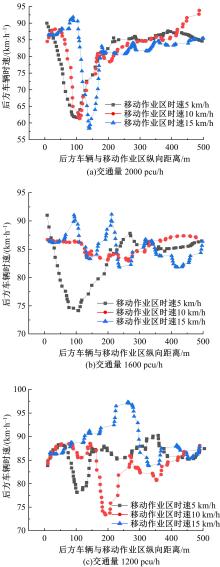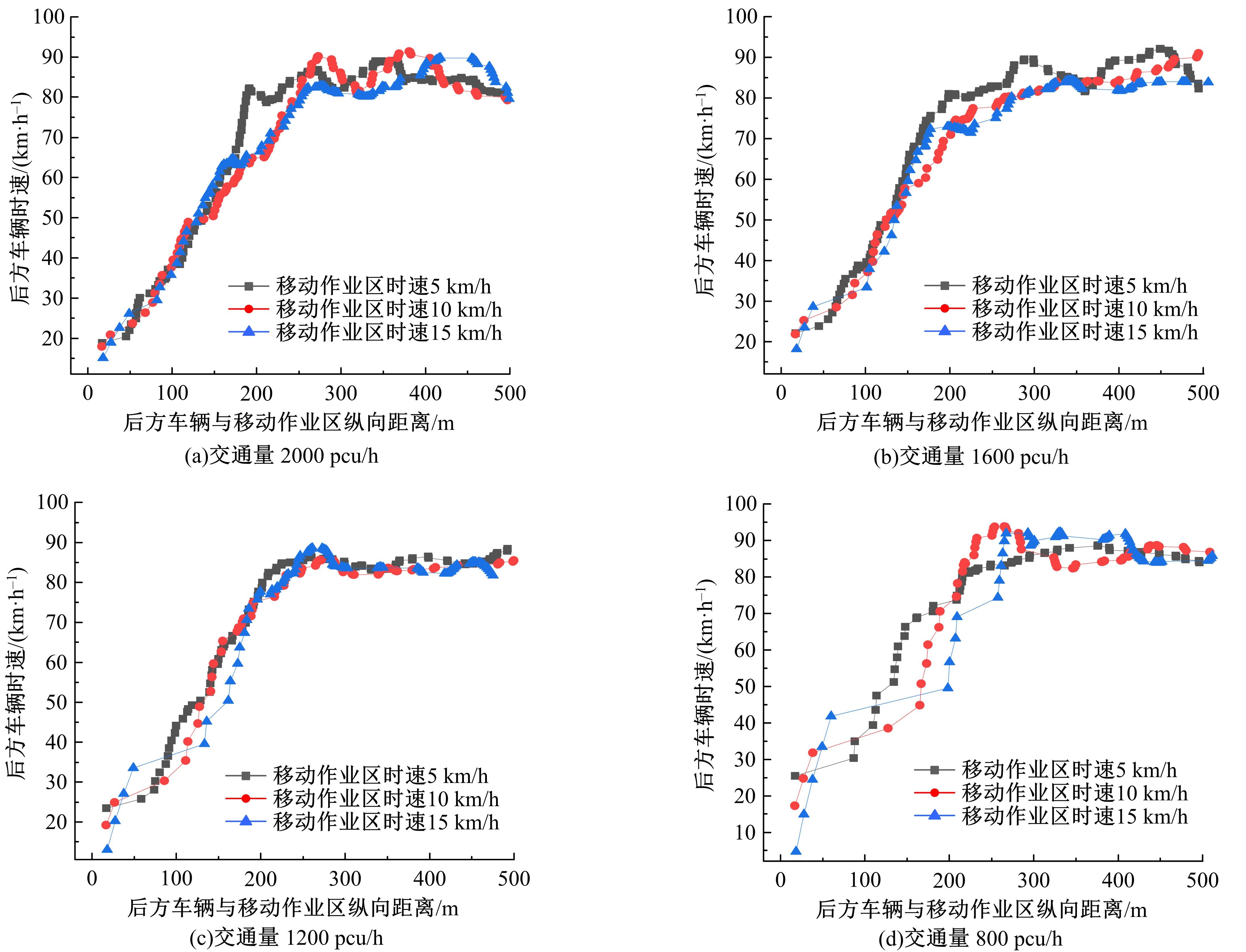Journal of Jilin University(Engineering and Technology Edition) ›› 2022, Vol. 52 ›› Issue (8): 1786-1791.doi: 10.13229/j.cnki.jdxbgxb20210154
Traffic risk analysis of moving work zone on right lane of city expressway
Song FANG1,2( ),Jian-xiao MA1(
),Jian-xiao MA1( ),Gen LI1,Ling-hong SHEN1,Chu-bo XU1
),Gen LI1,Ling-hong SHEN1,Chu-bo XU1
- 1.College of Automobile and Traffic Engineering,Nanjing Forestry University,Nanjing 210037,China
2.College of Locomotive and Vehicle,Nanjing Vocational Institute of Railway Technology,Nanjing 210031,China
CLC Number:
- U491
| 1 | Xu Wen-xiang, Zhao Xiao-hua, Chen Yu-fei, et al. Research on the relationship between dynamic message sign control strategies and driving safety in freeway work zones[J]. Journal of Advanced Transportation, 2018, 2018: 1-19. |
| 2 | Geza P, Robert E B. Work zone impact assessment methods and applications[J]. Transportation Research Record, 2017(2617): 52-59. |
| 3 | Li Ying-feng, Bai Yong. Development of crash-severity-index models for the measurement of work zone risk levels[J]. Accident Analysis and Prevention, 2008, 40(5): 1724-1731. |
| 4 | Meng Qiang, Weng Jin-xian. Evaluation of rear-end crash risk at work zone using work zone traffic data[J]. Accident Analysis and Prevention, 2011, 43(4): 1291-1300. |
| 5 | Mahmoud S, Ikuma L H, Fereydoun A, et al. Effects of work zone configurations and traffic density on performance variables and subjective workload[J]. Accident Analysis and Prevention, 2014, 71: 166-176. |
| 6 | Waleczek H, Geistefeldt J, Middendorf D C, et al. Traffic flow at a freeway work zone with reversible median lane[J]. Transportation Research Procedia, 2016, 15: 257-266. |
| 7 | Du S, Razavi S. Variable speed limit for freeway work zone with capacity drop using discrete-time sliding mode control[J]. Journal of Computing in Civil Engineering, 2019, 33(2): 04019001. |
| 8 | Ge H, Yang Y. Research on calculation of warning zone length of freeway based on micro-simulation model[J]. IEEE Access, 2020(8): 76532-76540. |
| 9 | Wu K, Zhong L. A method for determining length of freeway work zone based on classification of service level[J]. Advanced Materials Research, 2013, 779/780(1): 491-497. |
| 10 | 吴彪,许洪国,戴彤焱,等.高速公路作业区行车风险仿真评价模型[J].交通运输系统工程与信息, 2013, 13(3): 151-156. |
| Wu Biao, Xu Hong-guo, Dai Tong-yan, et al. Simulation evaluation model on driving risk of expressway work zone[J]. Journal of Transportation Systems Engineering and Information Technology, 2013, 13(3): 151-156. | |
| 11 | 彭余华,王晓玉,吕纪娜,等.基于服务水平的高速公路养护作业工作区长度确定方法[J].中国公路学报, 2016, 29(5): 130-136. |
| Peng Yu-hua, Wang Xiao-yu, Ji-na Lyu, et al. Length determination method for expressway maintenance work zone based on service level[J]. China Journal of Highway and Transport, 2016, 29(5):130-136. | |
| 12 | 吴江玲, 张生瑞, Singh A K, 等. 基于交通事故成本控制的高速公路施工区布局优化[J]. 长安大学学报: 自然科学版, 2017, 37(5): 97-103. |
| Wu Jiang-ling, Zhang Sheng-rui, Singh A K, et al. Optimum layout of freeway construction area based on crash cost control [J]. Journal of Chang'an University(Natural Science Edition), 2017, 37(5): 97-103. | |
| 13 | 于仁杰, 马荣国, 韩海, 等. 高速公路施工区限速标志位置确定方法[J]. 交通运输工程学报, 2013, 13(5): 91-98. |
| Yu Ren-jie, Ma Rong-guo, Han Hai, et al. Determination method of speed-limit sign position in expressway work zone[J]. Journal of Traffic and Transportation Engineering, 2013, 13(5): 91-98. | |
| 14 | 周育名, 魏建国, 陈致远, 等. 考虑多因素的高速公路养护区交通组织[J]. 长安大学学报: 自然科学版, 2020, 40(2): 99-108. |
| Zhou Yu-ming, Wei Jian-guo, Chen Zhi-yuan, et al. Traffic organization of expressway maintenance work zone with multi-factors[J]. Journal of Chang'an University(Natural Science Edition), 2020, 40(2): 99-108. | |
| 15 | 孟祥海, 郑来, 毕海峰, 等. 高速公路半幅封闭施工区交通特性与交通冲突特性研究[J]. 中国公路学报, 2013, 26(2): 140-146. |
| Meng Xiang-hai, Zheng Lai, Bi Hai-feng, et al. Research on traffic characteristics and traffic conflicts of one-way closed work zone on expressway[J]. China Journal of Highway and Transport, 2013,26(2): 140-146. | |
| 16 | 郭忠印, 戴忧华, 周小焕. 高速公路隧道(群)风险特征点的临界安全车速及其应用研究[J]. 中国公路学报, 2010, 23(): 116-122. |
| Guo Zhong-yin, Dai You-hua, Zhou Xiao-huan. Critical safety speed and its application research on risk characteristic section of expressway tunnel(tunnel group)[J]. China Journal of Highway and Transport, 2010, 23(Sup.1): 116-122. |
| [1] | Song-xue GAI,Xiao-qing ZENG,Xiao-yuan YUE,Zi-hao YUAN. Parking guidance model based on user and system bi⁃level optimization algorithm [J]. Journal of Jilin University(Engineering and Technology Edition), 2022, 52(6): 1344-1352. |
| [2] | Hong-feng XU,Hong-jin CHEN,Dong ZHANG,Qian-hui LU,Na AN,Xian-cai Geng. Fully⁃actuated signal timing technique for isolated signalized intersections in connected vehicle environment [J]. Journal of Jilin University(Engineering and Technology Edition), 2022, 52(6): 1324-1336. |
| [3] | Feng XUE,Chuan-lei HE,Qian HUANG,Jian LUO. Coordination degree of multimodal rail transit network [J]. Journal of Jilin University(Engineering and Technology Edition), 2021, 51(6): 2040-2050. |
| [4] | Bo PENG,Yuan-yuan ZHANG,Yu-ting WANG,Ju TANG,Ji-ming XIE. Automatic traffic state recognition from videos based on auto⁃encoder and classifiers [J]. Journal of Jilin University(Engineering and Technology Edition), 2021, 51(3): 886-892. |
| [5] | Dian-hai WANG,Xin-yi SHEN,Xiao-qin LUO,Sheng JIN. Offset optimization with minimum average vehicle delay [J]. Journal of Jilin University(Engineering and Technology Edition), 2021, 51(2): 511-523. |
| [6] | Xian-min SONG,Ming-ye ZHANG,Zhen-jian LI,Xin WANG,Ya-nan ZHANG. Setting of dynamic bus lane and its simulation analysis and evaluation [J]. Journal of Jilin University(Engineering and Technology Edition), 2020, 50(5): 1677-1686. |
| [7] | Hong-fei JIA,Xin-ru DING,Li-li YANG. Bi-level programming model for optimization design of tidal lane [J]. Journal of Jilin University(Engineering and Technology Edition), 2020, 50(2): 535-542. |
| [8] | Chao-ying YIN,Chun-fu SHAO,Xiao-quan WANG,Zhi-hua XIONG. Influence of built environment on commuting mode choice considering spatial heterogeneity [J]. Journal of Jilin University(Engineering and Technology Edition), 2020, 50(2): 543-548. |
| [9] | Da-wei ZHANG,Hai-tao ZHU. An optimization⁃based evacuation model considering pedestrian heterogeneity [J]. Journal of Jilin University(Engineering and Technology Edition), 2020, 50(2): 549-556. |
| [10] | Yuan-li GU, Yuan ZHANG, Xiao-ping RUI, Wen-qi LU, Meng LI, Shuo WANG. Short⁃term traffic flow prediction based on LSSVMoptimized by immune algorithm [J]. Journal of Jilin University(Engineering and Technology Edition), 2019, 49(6): 1852-1857. |
| [11] | Yi-ming BIE,Kai JIANG,Ru-ru TANG,Lin-hong WANG,Xin-yu XIONG. Time of interval partition for traffic control at isolated intersection considering impacts of plan transition [J]. Journal of Jilin University(Engineering and Technology Edition), 2019, 49(6): 1844-1851. |
| [12] | Guo-zhu CHENG, Si-he FENG, Tian-jun FENG. Setting condition of on⁃street parking space occupied vehicle lane [J]. Journal of Jilin University(Engineering and Technology Edition), 2019, 49(6): 1858-1864. |
| [13] | Quan LIANG,Jian-cheng WENG,Wei ZHOU,Jian RONG. Stability identification of public transport commute passengers based on association rules [J]. Journal of Jilin University(Engineering and Technology Edition), 2019, 49(5): 1484-1491. |
| [14] | Hai-bo LONG,Jia-qi YANG,Xue-yu ZHAO. Optimizing vehicles allocation of multimodal coordinated freight transport based on transshipment delay risks [J]. Journal of Jilin University(Engineering and Technology Edition), 2019, 49(5): 1492-1499. |
| [15] | Wen⁃jing WU,Run⁃chao CHEN,Hong⁃fei JIA,Qing⁃yu LUO,Di SUN. Collaborative control method of vehicles in U⁃turn zone under environment of cooperative vehicle infrastructure system [J]. Journal of Jilin University(Engineering and Technology Edition), 2019, 49(4): 1100-1106. |
|
||





